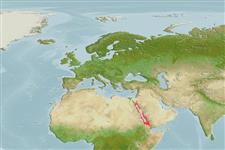Common names from other countries
>
Clupeiformes (Herrings) >
Dorosomatidae (Gizzard shads and sardinellas)
Etymology: Herklotsichthys: After Janus Adrian Herklots, Australian ichthyologist, 1820-1872.
More on author: Rüppell.
Environment: milieu / climate zone / depth range / distribution range
Ecologia
marinhas; intervalo de profundidade 0 - 50 m (Ref. 188). Subtropical; 37°N - 12°N, 29°E - 45°E (Ref. 188)
Western Indian Ocean: Red Sea and possibly Gulf of Aden; an immigrant into eastern Mediterranean Sea (Ref. 188). The names Herklotsichthys punctata and Herklotsichthys punctatus have been widely misused in the literature for another species, Herklotsichthys quadrimaculatus (Ref. 188).
Tamanho / Peso / Idade
Maturity: Lm ? range ? - ? cm
Max length : 11.7 cm TL macho/indeterminado; (Ref. 124816); common length : 9.5 cm TL macho/indeterminado; (Ref. 5450); peso máx. Publicado: 15.00 g (Ref. 124816)
Espinhos dorsais (total): 0; Raios dorsais moles (total): 13-21; Espinhos anais 0; Raios anais moles: 12 - 23. Flank silvery, without spots, but a series of small dark spots on back on either side of dorsal fin base or behind it.
Forms schools in coastal waters (Ref. 188). Marketed fresh, dried and dried salted or made into fish balls.
Life cycle and mating behavior
Maturidade | Reprodução | Desova | Ovos | Fecundidade | Larvas
Whitehead, P.J.P., 1985. FAO Species Catalogue. Vol. 7. Clupeoid fishes of the world (suborder Clupeoidei). An annotated and illustrated catalogue of the herrings, sardines, pilchards, sprats, shads, anchovies and wolf-herrings. FAO Fish. Synop. 125(7/1):1-303. Rome: FAO. (Ref. 188)
Categoria na Lista Vermelha da IUCN (Ref. 130435)
CITES (Ref. 128078)
Not Evaluated
Ameaça para o homem
Harmless
Utilização humana
Pescarias: pouco comercial
Mais informação
ReferênciasAquaculturaPerfil para aquaculturaEstirpesGenéticaElectrophoresesHereditariedadeDoençasProcessamentoMass conversion
ColaboradoresFotografiasStamps, Coins Misc.SonsCiguateraVelocidadeTipo de nataçãoÁrea branquialOutras referênciasCérebrosVisão
Ferramentas
Relatórios especiais
Descarregue XML
Fontes da internet
Estimates based on models
Preferred temperature (Ref.
115969): 25.1 - 29.4, mean 28.9 (based on 54 cells).
Phylogenetic diversity index (Ref.
82804): PD
50 = 0.5002 [Uniqueness, from 0.5 = low to 2.0 = high].
Bayesian length-weight: a=0.00912 (0.00433 - 0.01920), b=3.04 (2.87 - 3.21), in cm Total Length, based on LWR estimates for this (Sub)family-body shape (Ref.
93245).
Nível Trófico (Ref.
69278): 3.1 ±0.3 se; based on size and trophs of closest relatives
Resiliência (Ref.
120179): Elevada, tempo mínimo de duplicação da população menor que 15 meses (Preliminary K or Fecundity.).
Fishing Vulnerability (Ref.
59153): Low vulnerability (10 of 100).
